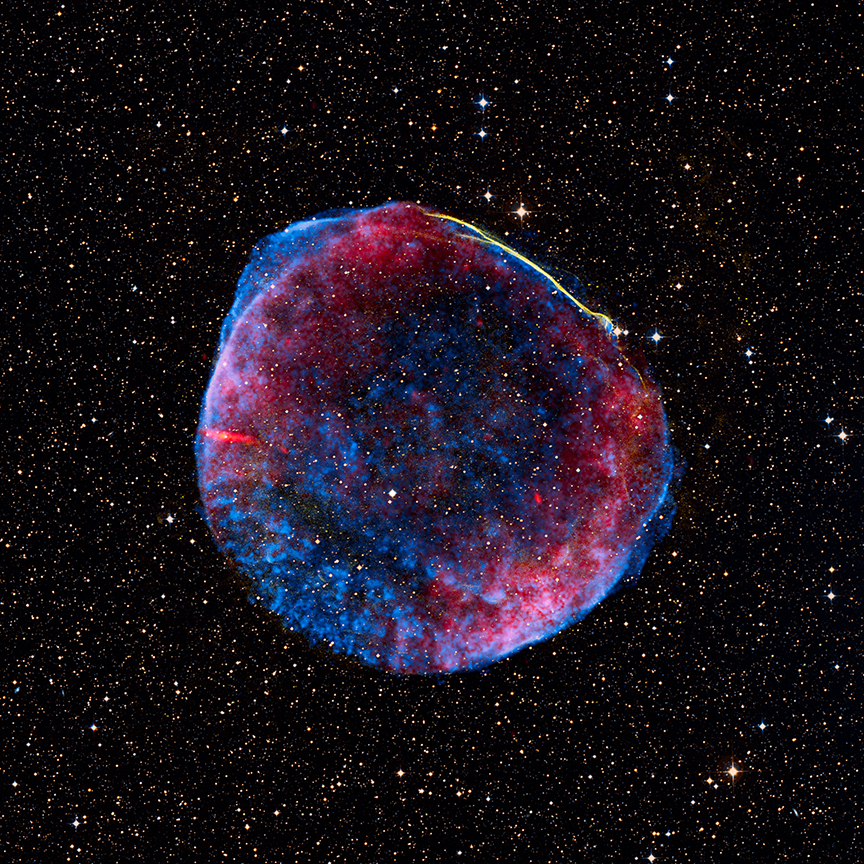
Just over a thousand years ago, the stellar explosion known as supernova SN 1006 was observed. It was brighter than Venus, and visible during the day for weeks. The brightest supernova ever recorded on Earth, this spectacular light show was documented in China, Japan, Europe, and the Arab world.
Ancient observers were treated to this celestial fireworks display without understanding its cause or implications. Astronomers now understand that SN 1006 was caused by a white dwarf star that captured mass from a companion star until the white dwarf became unstable and exploded. Recent observations of the remnant of SN 1006 reveal the liberation of elements such as iron that were previously locked up inside the star. Because no material falls back into a neutron star or black hole after this type of supernova explosion, the liberation of this star's contents is complete. It represents, therefore, a cosmic version of Independence Day for this star.
This is a composite image of the SN 1006 supernova remnant, which is located about 7000 light years from Earth. Shown here are X-ray data from NASA's Chandra X-ray Observatory (blue), optical data from the University of Michigan's 0.9 meter Curtis Schmidt telescope at the NSF's Cerro Tololo Inter-American Observatory (CTIO; yellow) and the Digitized Sky Survey (orange and light blue), plus radio data from the NRAO's Very Large Array and Green Bank Telescope (VLA/GBT; red).

A Bubble in Cygnus
Image Credit & Copyright: Keith Quattrocchi, Mel Helm
Explanation: Adrift in the rich star fields of the constellation Cygnus, this lovely, symmetric bubble nebula was only recently recognized and may not yet appear in astronomical catalogs. In fact, amateur astronomer Dave Jurasevich identified it as a nebula on July 6 in his images of the complex Cygnus region that included the Crescent Nebula (NGC 6888). He subsequently notified the International Astronomical Union. Only eleven days later the same object was independently identified by Mel Helm at Sierra Remote Observatories, imaged by Keith Quattrocchi and Helm, and also submitted to the IAU as a potentially unknown nebula. Their final composite image is seen here, including narrow-band image data that highlights the nebula's delicate outlines. What is the newly recognized bubble nebula? Like the Crescent Nebula itself, this cosmic bubble could be blown by winds from a massive Wolf-Rayet star, or it could be a spherically-shaped planetary nebula, a final phase in the life of a sun-like star.

APEX reveals glowing stellar nurseries
Illustrating the power of submillimetre-wavelength astronomy, an APEX image reveals how an expanding bubble of ionised gas about ten light-years across is causing the surrounding material to collapse into dense clumps that are the birthplaces of new stars. Submillimetre light is the key to revealing some of the coldest material in the Universe, such as these cold, dense clouds.
The region, called RCW120, is about 4200 light years from Earth, towards the constellation of Scorpius. A hot, massive star in its centre is emitting huge amounts of ultraviolet radiation, which ionises the surrounding gas, stripping the electrons from hydrogen atoms and producing the characteristic red glow of so-called H-alpha emission.
As this ionised region expands into space, the associated shock wave sweeps up a layer of the surrounding cold interstellar gas and cosmic dust. This layer becomes unstable and collapses under its own gravity into dense clumps, forming cold, dense clouds of hydrogen where new stars are born. However, as the clouds are still very cold, with temperatures of around -250˚ Celsius, their faint heat glow can only be seen at submillimetre wavelengths. Submillimetre light is therefore vital in studying the earliest stages of the birth and life of stars.

The Chandra Deep Field South, observed in the U-, B-, and R-bands with ESO's VIMOS and WFI instruments. The U-band VIMOS observations were made over a period of 40 hours and constitute the deepest image ever taken from the ground in the U-band. The image covers a region of 14.1 x 21.6 arcmin on the sky and shows galaxies that are 1 billion times fainter than can be seen by the unaided eye. The VIMOS R-band image was assembled by the ESO/GOODS team from archival data, while the WFI B-band image was produced by the GABODS team.
Because the Universe looks the same in all directions, the number, types and distribution of galaxies is the same everywhere. Consequently, very deep observations of the Universe can be performed in any direction. A series of fields were selected where no foreground object could affect the deep space observations (such as a bright star in our galaxy, or the dust from our Solar System). These fields have been observed using a number of telescopes and satellites, so as to collect information at all possible wavelengths, and characterise the full spectrum of the objects in the field. The data acquired from these deep fields are normally made public to the whole community of astronomers, constituting the basis for large collaborations.
Observations in the U-band, that is, at the boundary between visible light and ultraviolet are challenging: the Earth's atmosphere becomes more and more opaque out towards the ultraviolet, a useful property that protects people's skin, but limiting to ground-based telescopes. At shorter wavelengths, observations can only be done from space, using, for example, the Hubble Space Telescope. On the ground, only the very best sites, such as ESO's Paranal Observatory in the Atacama Desert, can perform useful observations in the U-band. Even with the best atmospheric conditions, instruments are at their limit at these wavelengths: the glass of normal lenses transmits less UV light, and detectors are less sensitive, so only instruments designed for UV observations, such as VIMOS on ESO's Very Large Telescope, can get enough light.

The Carina Nebula is a large bright nebula that surrounds several clusters of stars. It contains two of the most massive and luminous stars in our Milky Way galaxy, Eta Carinae and HD 93129A. Located 7500 light years away, the nebula itself spans some 260 light years across, about 7 times the size of the Orion Nebula, and is shown in all its glory in this mosaic. It is based on images collected with the 1.5-m Danish telescope at ESO''s La Silla Observatory. Being brighter than one million Suns, Eta Carinae (the brightest star in this image) is the most luminous star known in the Galaxy, and has most likely a mass over 100 times that of the Sun. It is the closest example of a luminous blue variable, the last phase in the life of a very massive star before it explodes in a fiery supernova. Eta Carinae is surrounded by an expanding bipolar cloud of dust and gas known as the Homunculus (''little man'' in Latin), which astronomers believe was expelled from the star during a great outburst seen in 1843.
Credit: ESO/IDA/Danish 1.5 m/R.Gendler, J-E. Ovaldsen, C. Thöne, and C. Feron.

Illusion and Evolution
What's happening to the galaxies of cluster Abell 2667? On the upper left, a galaxy appears to be breaking up into small pieces, while on the far right, another galaxy appears to be stretched like taffy.
To start, most of the yellowish objects in the above image from the Hubble Space Telescope are galactic members of a massive cluster of galaxies known as Abell 2667. The distortion of the galaxy on the upper left is real. As the galaxy plows through the intercluster medium, gas is stripped out and condenses to form bright new knots of stars. This detailed image helps astronomers understand why so many galaxies today have so little gas.
The distortion of the galaxy on the far right, however, is an illusion. This nearly normal galaxy is actually far behind the massive galaxy cluster. Light from this galaxy is gravitationally lensed by Abell 2667, appearing much like a distant person would appear through a wine glass. Each distorted galaxy gives scientists important clues about how galaxies and clusters of galaxies evolve.
Image Credit: NASA, ESA, Jean-Paul Kneib (Laboratoire dAstrophysique de Marseille) et al.

Officially known as 1E 0657-56, the Bullet Cluster was formed after the violent collision of two large clusters of galaxies. Llocated about 3.8 billion light years from Earth, this image combines an image from NASA's Chandra X-ray Observatory with optical data from the Hubble Space Telescope and Magellan telescope in Chile. The cluster has become an extremely popular object for astrophysical research, including studies of the properties of dark matter and the dynamics of million-degree gas.
In this latest research effort, the Bullet Cluster was used to search for the presence of antimatter leftover from the very early universe. Antimatter is made up of elementary particles that have the same masses as their corresponding matter counterparts -- protons, neutrons and electrons -- but the opposite charges and magnetic properties.

As the name implies, this reflection nebula associated with the star Rigel looks suspiciously like a fairytale crone. Formally known as IC 2118 in the constellation Orion, the Witch Head Nebula glows primarily by light reflected from the star. The color of this very blue nebula is caused not only by blue color of its star, but also because the dust grains reflect blue light more efficiently than red. A similar physical process causes Earth's daytime sky to appear blue.
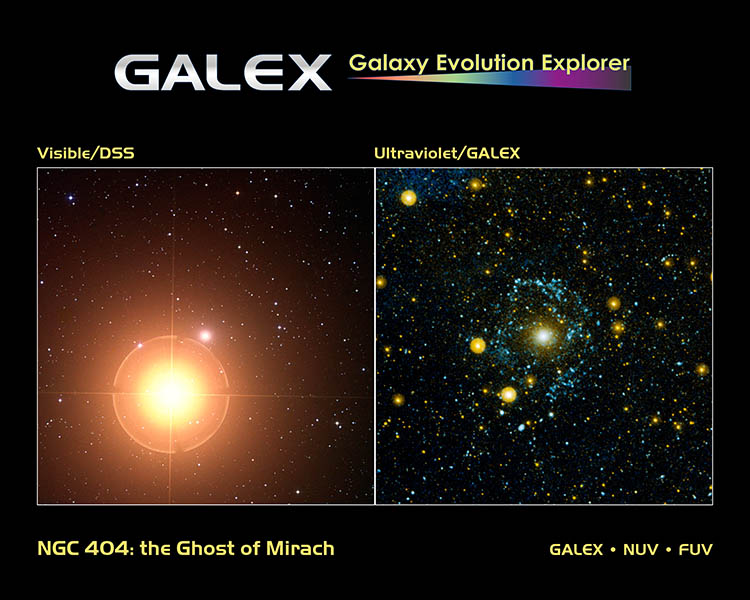
The "Ghost of Mirach" galaxy is shown in visible light on the left, and in ultraviolet as seen by NASA's Galaxy Evolution Explorer on the right. The fields of view are identical in both pictures, with the Ghost of Mirach -- a galaxy called NGC 404 -- seen as the whitish spot in the center of the images. Mirach is a red giant star that looms large in visible light. Because NGC 404 is lost in the glare of this star, it was nicknamed the Ghost of Mirach.
But when the galaxy is viewed in ultraviolet light, it comes to "life," revealing a never-before-seen ring. This ring, seen in blue in the picture on the right, contains new stars -- a surprise considering that the galaxy was previously thought to be, essentially, dead.
The field of view spans 55,000 light years across. The Ghost of Mirach is located 11 million light-years from Earth. The star Mirach is very close in comparison -- it is only 200 light-years away and is visible with the naked eye.
The visible data come from the Digitized Sky Survey of the Space Telescope Science Institute in Baltimore, Md.
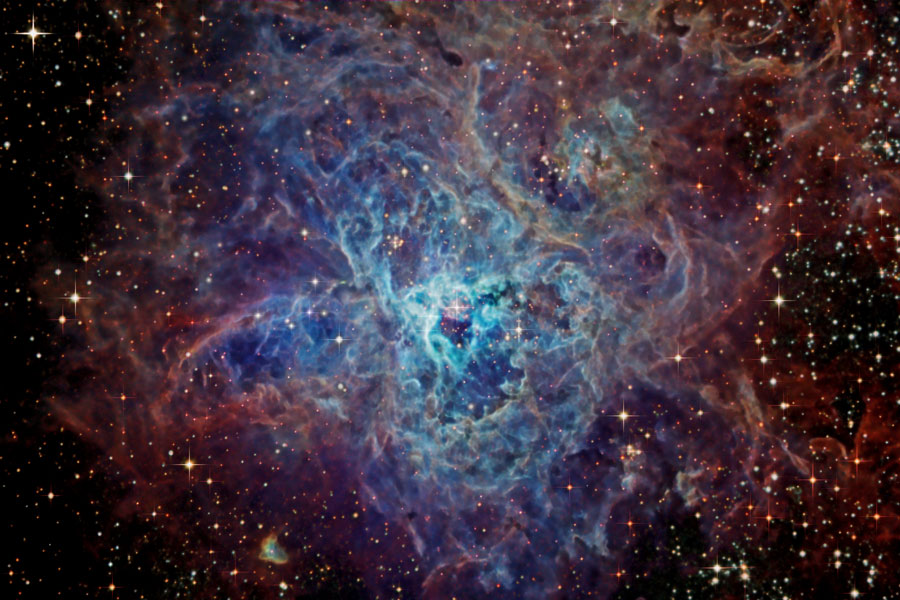
The Cosmic Web of the Tarantula Nebula
Credit & Copyright: Joseph Brimacombe
Explanation: First cataloged as a star, 30 Doradus is actually an immense star forming region in nearby galaxy The Large Magellanic Cloud. The region's spidery appearance is responsible for its popular name, the Tarantula nebula, except that this tarantula is about 1,000 light-years across, and 180,000 light-years away in the southern constellation Dorado. If the Tarantula nebula were at the distance of the Orion Nebula (1,500 light-years), the nearest stellar nursery to Earth, it would appear to cover about 30 degrees (60 full moons) on the sky. The spindly arms of the Tarantula nebula surround NGC 2070, a star cluster that contains some of the brightest, most massive stars known. Intriguing details of the nebula are visible in this scientifically-colored image. The cosmic Tarantula also lies near the site of the closest recent supernova.
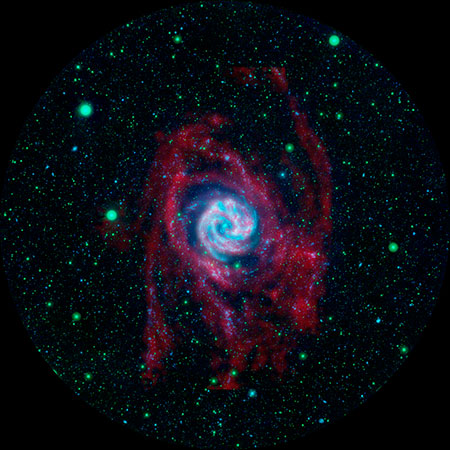
Beyond the Borders of a Galaxy
The outlying regions around the Southern Pinwheel galaxy, or M83, are highlighted in this composite image from NASA's Galaxy Evolution Explorer and the National Science Foundation's Very Large Array in New Mexico. The blue and pink pinwheel in the center is the galaxy's main stellar disk, while the flapping, ribbon-like structures are its extended arms.
The Galaxy Evolution Explorer is an ultraviolet survey telescope. Its observations, shown here in blue and green, highlight the galaxy's farthest-flung clusters of young stars up to 140,000 light-years from its center. The Very Large Array observations show the radio emission in red. They highlight gaseous hydrogen atoms, or raw ingredients for stars, which make up the lengthy, extended arms.
Astronomers are excited that the clusters of baby stars match up with the extended arms, because this helps them better understand how stars can be created out in the "backwoods" of a galaxy.
In this image, far-ultraviolet light is blue, near-ultraviolet light is green and radio emission at a wavelength of 21 centimeters is red.
Credit: NASA/JPL-Caltech/VLA/MPIA
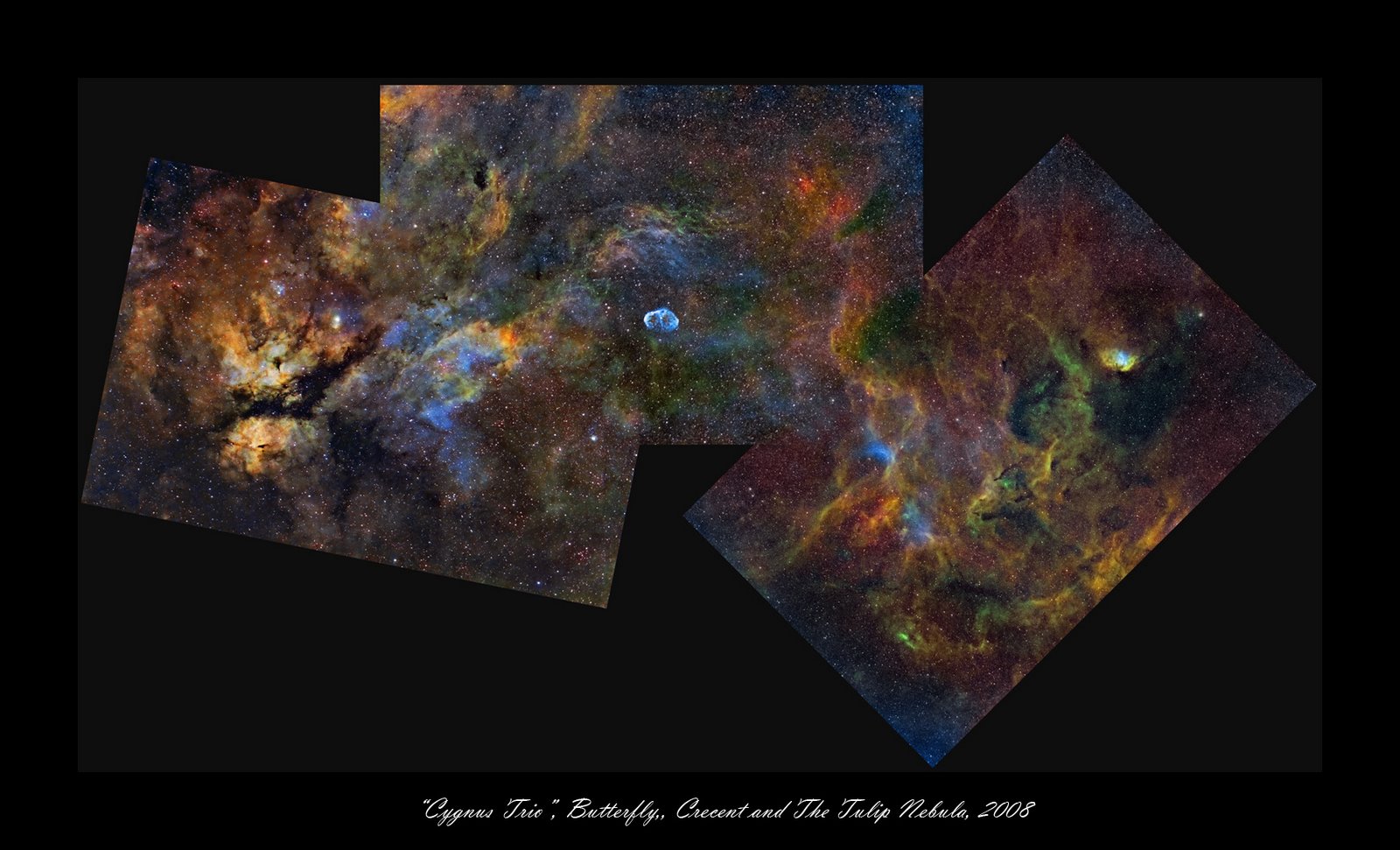
Cygnus Trio
Credit & Copyright: J-P Metsävainio (Astro Anarchy)
Explanation: In this colorful mosaic, filaments of gas and dust span some 9 degrees across central Cygnus, a nebula rich constellation along the northern Milky Way. A trio of nebulae with popular names highlights the beautiful skyscape - the Butterfly, the Crescent, and the Tulip. At left, the Butterfly Nebula (IC 1318), lies near bright star Gamma Cygni. The Butterfly's expansive, glowing, wing-shaped gas clouds are divided by a dark dust lane. Near center, the Crescent Nebula (NGC 6888) is more compact, a cosmic bubble with a bright edge blown by winds from a massive Wolf-Rayet star. On the right is the Tulip Nebula (Sh2-101), a small emission region shaped like a blossoming flower viewed from the side. All are within a few thousand light-years of the Sun in the Orion spiral arm of our galaxy. The gorgeous mosaic is presented in false color, constructed from image data recorded through narrow band filters. The range of colors was created by a mapping of emission from hydrogen, sulfur and oxygen atoms in the nebula to red, green, and blue hues.

Two Black Holes Dancing in 3C 75
Credit: X-Ray: NASA / CXC / D.Hudson, T.Reiprich et al. (AIfA);
Radio: NRAO / VLA/ NRL
Explanation: What's happening at the center of active galaxy 3C 75? The two bright sources at the center of this composite x-ray (blue)/ radio (pink) image are co-orbiting supermassive black holes powering the giant radio source 3C 75. Surrounded by multimillion degree x-ray emitting gas, and blasting out jets of relativistic particles the supermassive black holes are separated by 25,000 light-years. At the cores of two merging galaxies in the Abell 400 galaxy cluster they are some 300 million light-years away. Astronomers conclude that these two supermassive black holes are bound together by gravity in a binary system in part because the jets' consistent swept back appearance is most likely due to their common motion as they speed through the hot cluster gas at 1200 kilometers per second. Such spectacular cosmic mergers are thought to be common in crowded galaxy cluster environments in the distant universe. In their final stages the mergers are expected to be intense sources of gravitational waves.
Saturn

Carolyn Porco
Cassini Imaging Team Leader
I'm very happy to report that we've just put one more major milestone in this remarkable adventure successfully behind us.
Another bold dip over the south pole of Enceladus and another skillful setup for imaging the moon 'on the fly' have brought us another bounty of positively glorious views of one of the most fabulous places in the solar system.
On this run, we have captured, by design, jet source regions we didn't catch the first time: sources VI (see
http://www.nasa.gov/mission_pages/cassini/multimedia/pia11134.html )
and VII ( see
http://www.nasa.gov/mission_pages/cassini/multimedia/pia11127.html ) on and near the Baghdad tiger stripe, and we repeated our imaging of II and III on Damascus. In all, we've now seen at very high resolution (tens of meters per pixel) sources I, II, III, V, VI, and VII. (See
http://photojournal.jpl.nasa.gov/catalog/?IDNumber=pia08385 for a map of these locales). And of course, as before, we note that the region of the active tiger stripes is finely-fractured throughout and littered with icy blocks.
Our next flyby of Enceladus, as you may know, is not for another year. The sun will be disappearing from the south pole throughout that time, so that by next year we will have a far dimmer view of a shrinking portion of the south polar terrain. So, take your fill of this fabulous place now, because it will be a very, very long time before you see it like this again.

The Cassini spacecraft focuses on a streamer-channel feature in Saturn's F ring.
These features are created by the moon Prometheus as it closely approaches the ring once per orbit (see PIA08397).
This view looks toward the unilluminated side of the rings from about 36 degrees above the ringplane.The image was taken in visible light with the Cassini spacecraft narrow-angle camera on Sept. 30, 2008. The view was acquired at a distance of approximately 970,000 kilometers (602,000 miles) from Saturn and at a Sun-ring-spacecraft, or phase, angle of 45 degrees. Image scale is 5 kilometers (3 miles) per pixel.
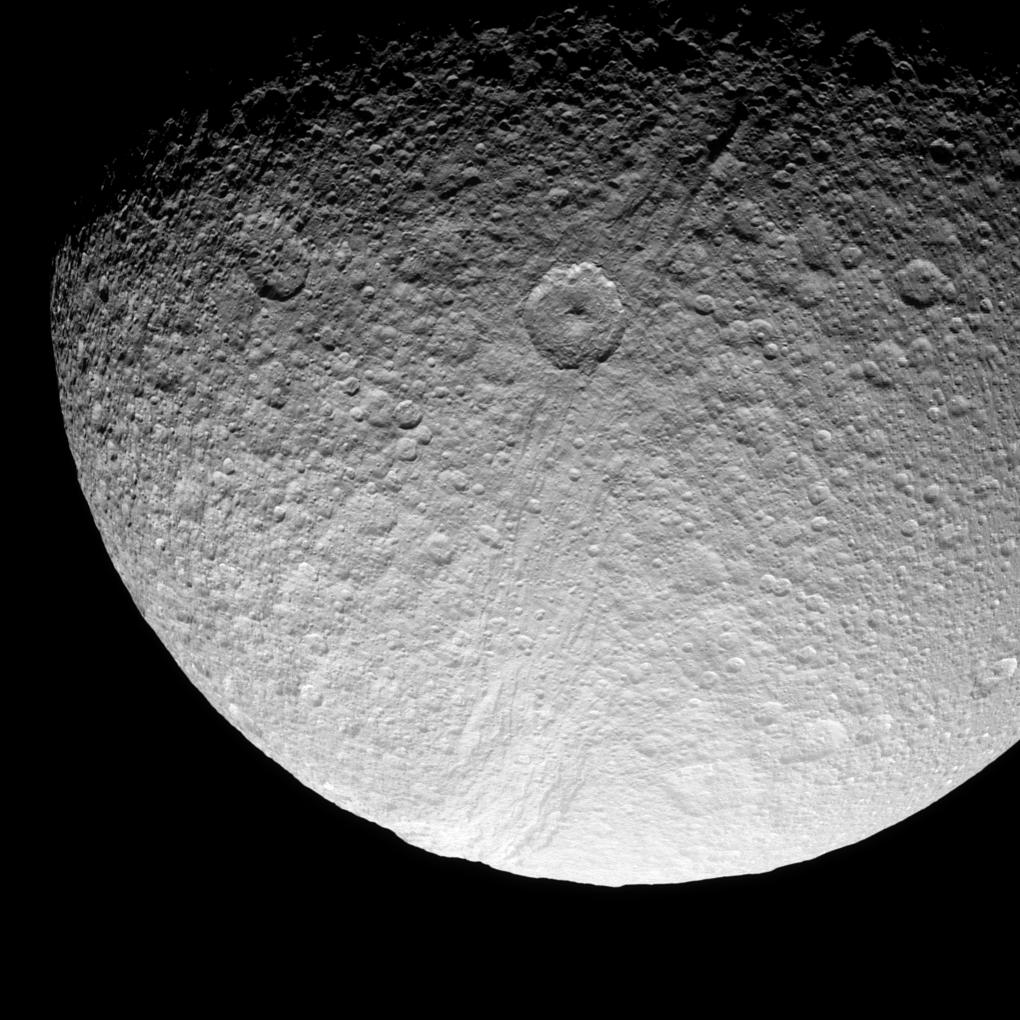
The prominent crater Telemachus sits within the northern reaches of Ithaca Chasma on Saturn's moon Tethys.
Ithaca Chasma is an enormous rift that stretches more than 1,000 kilometers (620 miles) from north to south across Tethys.
This view looks toward the Saturn-facing side of Tethys (1,062 kilometers, or 660 miles across) from a position 55 degrees north of the moon's equator. The image was taken in visible light with the Cassini spacecraft narrow-angle camera on Sept. 24, 2008. The view was acquired at a distance of approximately 151,000 kilometers (94,000 miles) from Tethys and at a Sun-Tethys-spacecraft, or phase, angle of 61 degrees. Image scale is 903 meters (2,962 feet) per pixel.
Mars
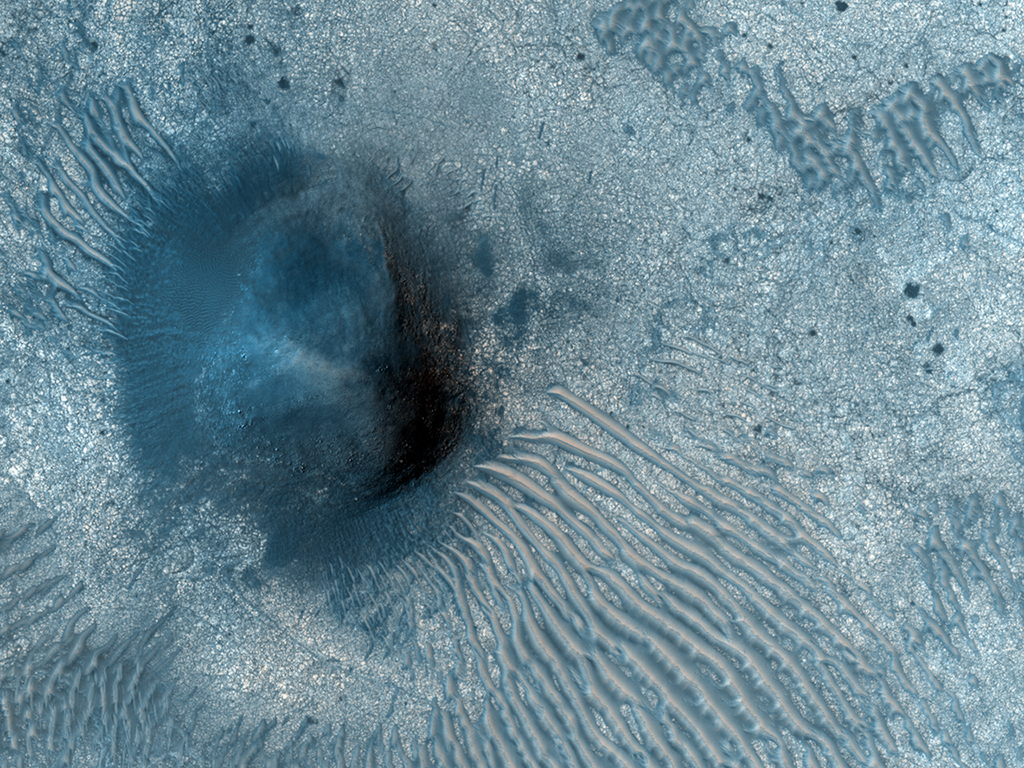
This image covers a flat plain in the Nili Fossae region of Mars. The portion shown here is roughly 400 meters, or 1/4 mile, across.
Bright, fractured bedrock is visible underlying dunes or ripples of wind-blown sand. The parallel, dark blue curves across the bedrock surface (underneath the dunes) are the edges of successive rock layers. These may appear dark blue because dark sand has become trapped at the edges of the layers. Successive layers in the bedrock are also exposed in the walls of degraded impact craters elsewhere in the image.
The layered rocks here are billions of years old, and infrared spectra from the CRISM instrument have inferred that they contain minerals such as clays and carbonate that likely formed when liquid water chemically altered these rocks. This evidence for past water activity, combined with the general flatness of this particular location, make it a good candidate landing site for future Mars rover missions.
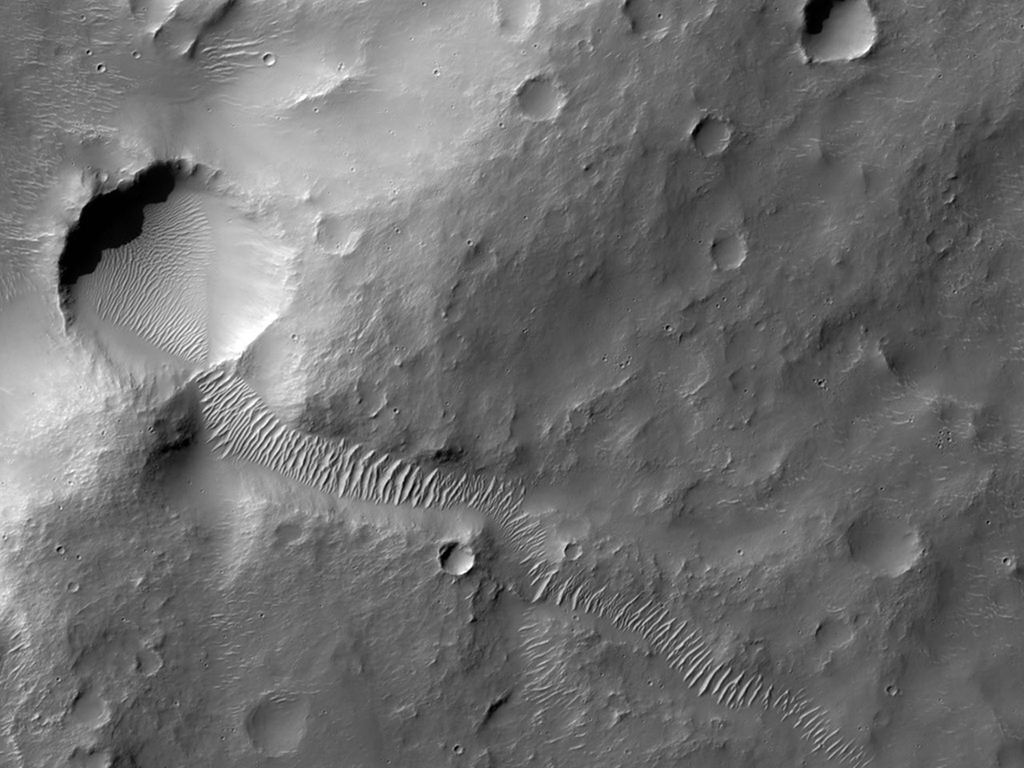
This image shows the southeast rim of a large degraded crater where a valley breaches the crater rim. The valley itself, no longer pristine, is difficult to locate in the image.
However, it appears to be in the center near the right of the crater rim. It is possible that this valley transported water into the crater forming a lake in the ancient past.
The scene is peppered with craters of various sizes and states of degradation, indicating that the surface is not young. A few craters are young enough to still have raised rims. One of these, located on the floor of the larger crater, has distinct raised ejecta radiating out from it.
The crater also has dunes on its floor, indicating that aeolian (wind) processes have modified it since it formed.

This crater with spectacular ejecta is located in the northern mid-latitudes in the Deuteronilus Mensae, located near the dichotomy boundary, where the southern highlands transition into the northern lowlands.
The crater has raised, fluidized ejecta. Scientists think that fluidized ejecta forms when an impact occurs into ice-rich material. The interior of the crater shows some material, particularly on the west wall, that has detached and is flowing into the crater center. This suggests the presence of ground ice.

Phoenix and the Holy Cow
Image Credit: Marco Di Lorenzo, Kenneth Kremer,
Phoenix Mission, NASA, JPL, UA, Max Planck Inst., Spaceflight
Explanation: The northern Martian summer is waning. As predicted, a decline in daylight hours, deteriorating weather, and dust storms are preventing solar arrays on the Phoenix Mars Lander from providing power. Phoenix's last signal was received on November 2, its successful mission ending after more than five months in the arctic region of the Red Planet, a run that exceeded its planned operational lifetime. Attempting to discover if Mars' surface has ever been able to support microbial life, Phoenix performed an extensive analysis of the soil and returned a wealth of image data. Of course, one of the lander's most exciting results was the detection of water-ice near the Martian surface. Recorded in October, this picture from the lander's Robotic Arm Camera shows the region under the Phoenix with flat, exposed icy patches. That area caused researchers to exclaim "Holy Cow!" when it was first imaged a few days after the May 25 touchdown of the Phoenix Mars Lander.
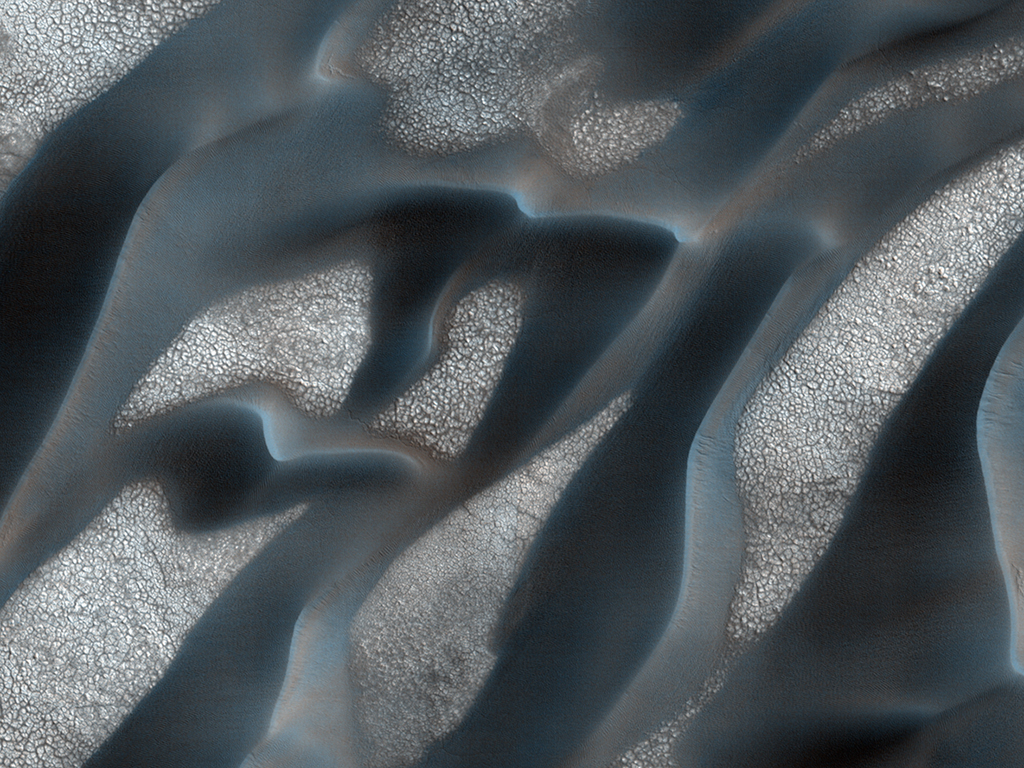
In this enhanced-color image are dunes within the largest collection of dunes on Mars, Olympia Undae, near the margin of the north polar deposits, Planum Boreum.
This section of Olympia Undae is particularly interesting because the dunes are rich in gypsum, a mineral that forms in the presence of water. The material comprising these dunes is thought to have eroded from geologic units near the base of the polar deposits, but these units have poor to no gypsum content. Therefore, water likely affected these dunes after the sand had eroded out from the polar deposits. Several ideas have been proposed to explain the formation of gypsum, including hydrothermal (hot water) activity and melting of water-ice in the polar deposits.
While gypsum dunes on Earth (for example, at White Sands, New Mexico) are white (the color of gypsum), these Martian dunes are dark due to the presence of basaltic grains that lower the brightness of the dunes. CRISM, another instrument on MRO, has found that the crests of the dunes are the most gypsum-rich.
So, what is the bright, polygonally-fractured material in the low spaces between the dunes? Perhaps it is polar ice lying beneath, desiccated (dried) gypsum material whose fine grain size makes it difficult for CRISM to detect, or something else altogether.
Moon

NASA has released a fully restored 42-year-old image of Earth taken from the moon. The image was released as part of a project that will allow scientists at NASA and beyond to compare historical images of the moon with new images that will be captured when NASA sends new missions to the moon in the coming years.
The image shown above, the "image of the century," was the first ever taken in which Earth is seen from another celestial body. In it, it is possible to see the north coast of Africa, as well as the glint of the sun on the Atlantic Ocean, said Wingo.